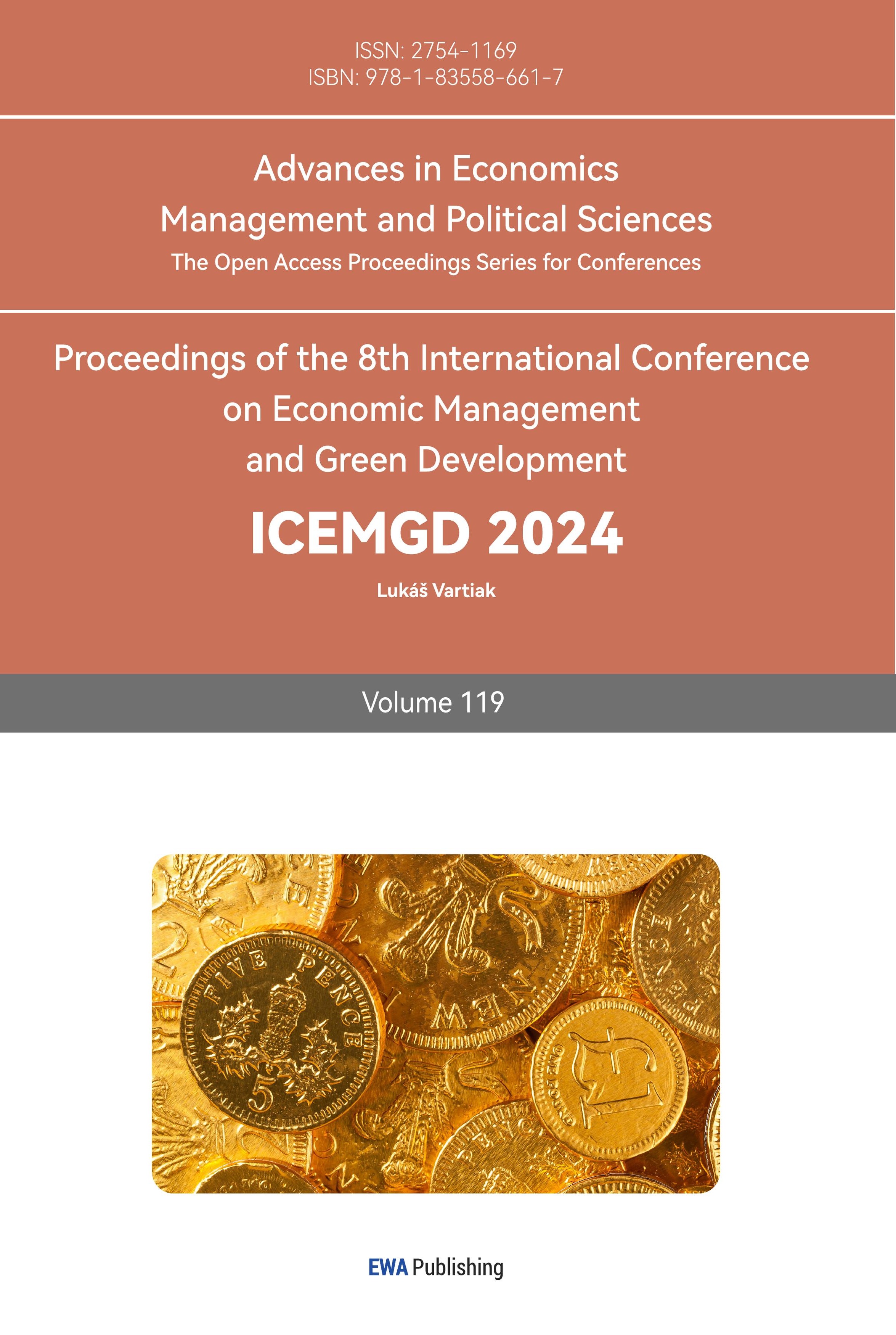1. Introduction
In the annals of athletic competition, the marathon stands out as a testament to human endurance and spirit. From its mythic origins in ancient Greece, where Pheidippides ran from Marathon to Athens, this storied race has evolved into a global phenomenon that captivates millions. In Figure 1, there’s an obvious trend that more and more people participating running and jogging. Every year, the proportion of Chinese citizens engaging in physical activity has been rising, suggesting a growing public awareness of health and fitness (Figure 2).Today, as we navigate through a rapidly changing world marked by technological leaps, societal shifts, and a heightened awareness of environmental and health issues, the marathon too is transforming.
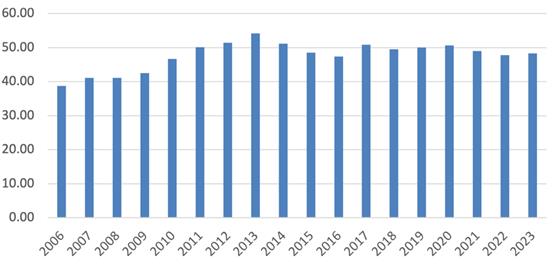
Figure 1: Number of running and jogging participants in the United States from 2010 to 2023 (in millions) (Picture credit: Original)

Figure 2: Number of sports and fitness venues in China from 2019 to 2022 (in 1,000 thousands) (Picture credit: Original)
This essay explores the dynamic forces reshaping this venerable sport and considers what lies ahead. At the core of our exploration is the integration of cutting-edge technology in sports equipment, particularly footwear, the revenue of athletic footwear industry in United State has experienced a huge growth and expected continuing into the future. Figure 3 has significantly enhanced performance but also sparked debates over fairness. The impact of the COVID-19 pandemic has not only accelerated the popularity of virtual marathons, offering runners new ways to compete and connect, but it has also emphasized the need for adaptability in traditional marathon formats.
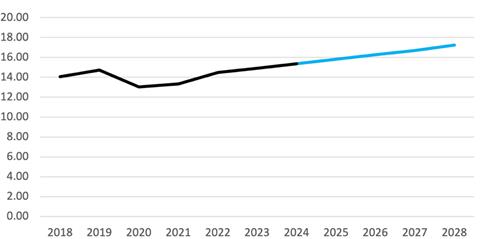
Figure 3: Revenue of the athletic footwear industry in the United States from 2018 to 2028 (in billion U.S. dollars) (Picture credit: Original)
Furthermore, as environmental concerns become increasingly urgent, marathons are adopting sustainable practices, reducing their ecological footprint and promoting eco-conscious behaviors among participants. This essay delves into these topics through a synthesis of expert insights, research, and analysis, aiming to illuminate the evolving landscape of marathon running. By understanding these trends, we can envision a future where marathons continue to inspire, innovate, and foster a sense of community across the globe.
2. Technological Advancements in Marathon Equipment
The latest technological advancements in marathon equipment have significantly impacted performance, particularly through the development of advanced footwear technology. These advancements have been observed across various studies and analyses, highlighting their influence on running economy and overall performance in elite runners. In Figure 4 and 5, popular sport brand Nike’s revenue has an incredible increasing trend compare to other fitness brand like Puma or adidas. This is because Nike always innovate and release newest technology on their product, especially marathon shoes.
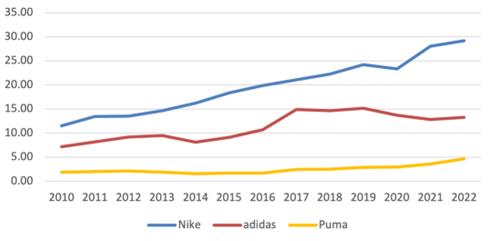
Figure 4: Footwear segment revenue of Nike, adidas & Puma 2010-2022(in billion U.S. dollars) (Picture credit: Original)
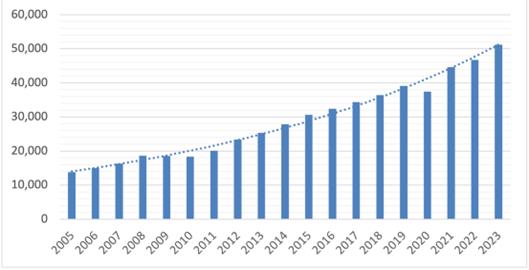
Figure 5: Nike's revenue worldwide from the fiscal years of 2005 to 2023 (in million U.S. dollars)
(Picture credit: Original)
Running performance has been demonstrated to be improved by advanced footwear technology, which is defined by characteristics like a stiff plate implanted inside the midsole, curved plate and midsole geometry, and lightweight, robust, high-energy returning foam [1]. When using these shoes compared to not wearing them throughout the same period, male elite distance runners' crucial speeds improved by 3.31% because to this technology [2]. Super shoes are thought to provide gains of about 4% for running economy and 2% for performance; super spikes may also have similar improvements [1]. This implies that improvements in shoe technology have an impact on running efficiency as well as the capacity to run faster for longer periods of time.
Seasonal best timings for both male and female elite runners in distance running competitions, including marathons, significantly decreased when new footwear technology was introduced [3]. Adopting this new shoe technology specifically resulted in a considerable performance boost (1.7%) for female marathoners, with their time being improved by roughly 2 minutes and 10 seconds [3]. This suggests that technical developments have an impact on female athletes' performance in addition to helping elite athletes.
Furthermore, the employment of cutting-edge footwear technology has made major running accomplishments possible. For example, Eliud Kipchoge's attempt to complete a marathon in under two hours while donning Nike's Alphafly shoes was not officially recognized because of regulated race circumstances [4]. There is evidence of a performance-enhancement impact, with a 10% increase in the likelihood that a new world record for marathon would be set in 2021 [4], despite debates on the fairness of wearing such shoes.
Wearable technology has also contributed to our awareness of and ability to improve running performance, in addition to footwear technology. Wearable sensors have been used to measure changes in running patterns over the course of a marathon, offering valuable information about the impact of fatigue on running biomechanics [5]. By enabling tailored data tracking and analysis, this technology can help runners maximize their performance and possibly avoid injuries [6].
In conclusion, performance has been significantly impacted by the most recent technological developments in marathon equipment, especially in sophisticated footwear technology. Elite runners' essential speed, running economy, and overall performance have all improved as a result of these developments. Although there is ongoing discussion about how these technologies may affect the fairness of competition, their application has allowed for notable successes in distance running events. Wearable technology has also improved our knowledge of injury prevention and running biomechanics, which improves both runners' performance and safety.
3. Long-term Impact of COVID-19 pandemic on virtual and online marathons
Future virtual and online marathons will be greatly impacted by the COVID-19 pandemic, with immediate and long-term implications for participation rates. (Figure 6). Running and jogging are the second most common outdoor activities in the United States, with 56.9 million participants as of 2022. Virtual marathons offer a suitable setting for anyone seeking self-challenge.
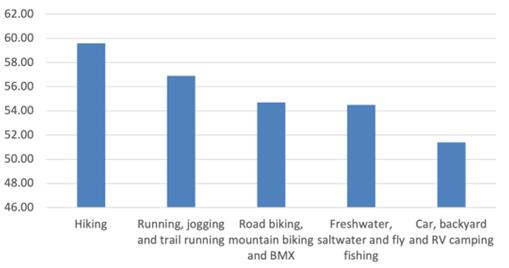
Figure 6: Leading outdoor activities in the United States in 2022, by number of participants (in millions) (Picture credit: Original)
3.1. Shift Towards Virtual marathons
Virtual technology is becoming more and more integrated into sports, especially marathons, thanks to the epidemic. Virtual marathons are becoming more and more popular as an addition to or replacement for conventional races among runners and event planners [7-9]. The emergence of online fitness services and the increasing inclination towards "online + offline" forms of physical activity lend credence to this change [10, 11].
3.2. Continued Interest and Participation
There is evidence to imply that participants have a persistent interest in virtual marathons. Participants' motivation for taking part in virtual marathons is still strong, driven by things like self-worth, social engagement, achievement, and health advantages [8]. Furthermore, the epidemic has promoted a greater understanding of the value of physical activity and fitness, which may result in higher participation rates in traditional and virtual marathons after the pandemic [12].
3.3. Challenges in Resuming In-Person Racing
When local regulations permit, runners are eager to participate in live races again, but health and safety concerns continue to be major obstacles. Concerns regarding congested circumstances, COVID-19 cases at race sites, and participant numbers are raised by runners [13]. These worries emphasize how crucial it is to carefully prepare, carry out mitigation techniques, and adhere to safety procedures in order to guarantee the safe restart of in-person marathons [14].
In summary, the COVID-19 pandemic has had a significant influence on the future of online and virtual marathons, causing a brief drop in participation rates as a result of safety and health concerns. On the other hand, it has also promoted a sustained interest in running activities and has expedited the development of virtual marathons. Virtual and regular marathons are expected to coexist as regulations loosen and safety precautions are put in place, giving runners additional opportunities to partake in this well-liked form of exercise.
4. Marathon is a sustainable practice to reduce environmental impact
The resources presented demonstrate how marathons are implementing a variety of sustainable methods to lessen their environmental effect. These methods fall into a few main categories: cutting down on trash production, encouraging eco-friendly conduct among attendees, lowering transportation-related carbon emissions, and improving the event's overall sustainability through strategic planning.
4.1. Reducing Carbon Footprint from Transportation
By focusing on lowering the carbon dioxide emissions caused by participants' travel habits, the Olympus Marathon has demonstrated a great interest in adopting an environmentally friendly strategy [15]. Given that a large percentage of marathon runners travel abroad to compete in competitions, which greatly increases their carbon footprint, this endeavor is essential. For example, 37 percent of runners in the New York Marathon go abroad, and a transatlantic flight to New York accounts for 3.5 tons CO2e, or 83% of the average French citizen's annual carbon footprint [16].
4.2. Minimizing Waste Generation
The London Marathon made significant changes to reduce the use of plastic water bottles, distributing paper cups instead [17]. This move addresses the issue of waste accumulation at marathons, where large quantities of food waste, packaging, and plastic bottles are commonly found after events. By adopting more sustainable packaging solutions, marathons can significantly reduce their environmental impact.
4.3. Promoting Eco-Friendly Behaviors Among Participants
The Olympus Marathon's case study highlights efforts to analyze mountain runners' environmental orientation and investigate their voluntary carbon offsetting behavioral intentions [15]. This approach not only encourages participants to adopt more sustainable behaviors but also develops marketing plans to support pro-environmental actions in sport events. Such initiatives can lead to a broader acceptance and implementation of sustainable practices within the marathon community.
4.4. Enhancing Overall Sustainability Through Strategic Planning
The Yantai City Marathon's research emphasizes the importance of integrating sustainable development theories and perspectives into event planning [18]. Strategies proposed include establishing long-term mechanisms for volunteer selection, improving service quality, and enhancing organizational management skills to ensure the event's sustainable development. Additionally, the analysis of small and medium-sized city marathons suggests that addressing issues such as resource optimization and multi-functional utilization of race tracks can contribute to sustainable development [19].
In conclusion, marathons are increasingly recognizing the need to adopt sustainable practices to mitigate their environmental impact. These efforts range from reducing carbon emissions associated with participant travel to minimizing waste generation and promoting eco-friendly behaviors among participants. Through strategic planning and implementation of these practices, marathons can play a significant role in advancing sustainability within the sports industry and beyond.
5. Suggestions and Measures for Improvement
In order to further improve marathons in the future, a number of suggestions and enhancements are made. To guarantee a level playing field, it is imperative to strike a balance between innovation and fairness, maybe by standardizing footwear technology. The creation of captivating digital platforms can provide a more immersive and participatory experience for virtual marathons, maintaining the momentum established during the pandemic. In order to reduce their ecological imprint, marathons should set more ambitious sustainability goals, such as carbon neutrality and zero-waste regulations. Moreover, encouraging knowledge and participation in the community can spark beneficial environmental change on a local and global scale.
6. Conclusion
In conclusion, marathons are more than just sporting events; they are also a representation of the abilities and values of our culture. Human limitations have been pushed by performance technology, and the epidemic has ushered in a new era of virtual engagement that has proven adaptable and resilient. Emphasize the urgent need for more extensive ecological protection in view of the growing number of individuals participating in marathons. Additionally, there is a tremendous upward trend in the sport brand revenues, which suggests that marathons have enormous commercial potential. All things considered, these trends suggest that in order to maintain marathons as a viable event in the twenty-first century, it is important to strike a balance between the pursuit of greatness and the ideals of justice and sustainability.
In addition, there are still certain problems with this research. The thesis, for instance, says nothing about future developments in marathon running shoe technology or how to mitigate the environmental damage that marathons cause. Future marathon runners will become more and more common, and this will draw attention to the environmental problems they cause.
References
[1]. Hébert-Losier, K. and Pamment, M. (2022). Advancements in running shoe technology and their effects on running economy and performance – a current concepts overview. Sports Biomechanics, 22(3), 335 - 350.
[2]. Rodrigo-Carranza, V., González-Mohíno, F. et al. (2023). Impact of advanced footwear technology on critical speed and performance in elite runners. Footwear Science,15, 9 - 15.
[3]. Bermon, S., Garrandes, F., Szabo, A., Berkovics, I., & Adami, P. E. (2021). Effect of advanced shoe technology on the evolution of road race times in male and female elite runners. Frontiers in Sports and Active Living, 3, 653173.
[4]. Arderiu, A., & de Fondeville, R. (2022). Influence of advanced footwear technology on sub-2 hour marathon and other top running performances. Journal of Quantitative Analysis in Sports, 18(1), 73-86.
[5]. Clermont, C. A., Benson, L. C., Edwards, W. B., Hettinga, B. A., & Ferber, R. (2019). New considerations for wearable technology data: changes in running biomechanics during a marathon. Journal of Applied Biomechanics, 35(6), 401-409.
[6]. Clermont, C. A., Duffett-Leger, L., Hettinga, B. A., & Ferber, R. (2020). Runners’ perspectives on ‘smart’wearable technology and its use for preventing injury. International Journal of Human–Computer Interaction, 36(1), 31-40.
[7]. Scheer, V., Valero, D., Villiger, E., Rosemann, T., & Knechtle, B. (2021). The impact of the COVID-19 pandemic on endurance and ultra-endurance running. Medicina, 57(1), 52.
[8]. Zhang, C. (2022). Research on the construction of online marathon participation intention model under the background of new crown epidemic. Nanchang: Jiangxi Normal University. (In Chinese)
[9]. Deng, S. (2022). Research on the participation behavior of Chinese runners in online marathon under the background of epidemic. Beijing: Capital University of Physical Education. (In Chinese)
[10]. Liu, D.F., & Fu, G.Q. (2020). A study on the factors influencing users' willingness to continue using online fitness services during the new coronavirus pneumonia epidemic. Research on Physical Education, 34(02): 41-50. (In Chinese)
[11]. Huang, Y., & Liu J. (2021). Transformation and influence of network communication of sports activities during the epidemic. Journal of Guangzhou Sports Institute, 41(03): 54-59. (In Chinese)
[12]. Tian, Y. (2022). PEST analysis and promotion strategy of online fitness development in the post epidemic period. Sports Culture Guide, 29(43): 59-66. (In Chinese)
[13]. Robinson, J. N., Fontana, M. A., Metzl, J. D., Dixit, S., Kliethermes, S. A., Quijano, B., & Toresdahl, B. (2021). Running races during the COVID-19 pandemic: a 2020 survey of the running community. BMJ Open Sport & Exercise Medicine, 7(4), e001192.
[14]. Woyo, E., & Nyamandi, C. (2022). Application of virtual reality technologies in the comrades’ marathon as a response to COVID-19 pandemic. Development Southern Africa, 39(1), 20-34.
[15]. Triantafyllidis, S., & Kaplanidou, K. (2022). Environmental Protection in Nature-Based Sport Events: The Case of Olympus Marathon. Case Studies in Sport Management, 11(S1), S25-S28.
[16]. Castaignède, L., Veny, F., Edwards, J., & Billat, V. (2021). The carbon footprint of Marathon runners: Training and racing. International Journal of Environmental Research and Public Health, 18(5), 2769.
[17]. Hu Y. (2019). Making the marathon environmentally friendly. English Painting Journal (Advanced Edition), 26: 6. (In Chinese)
[18]. Zhang S. Research on sustainable development of marathon in Yantai City. Yantai: Ludong University. (In Chinese)
[19]. Li Q. (2017). Analysis of sustainable development of marathon events in small and medium-sized cities. Contemporary Sports Science and Technology, 7(15): 172-173. (In Chinese)
Cite this article
Ni,R. (2024). The Future of Marathon. Advances in Economics, Management and Political Sciences,119,149-156.
Data availability
The datasets used and/or analyzed during the current study will be available from the authors upon reasonable request.
Disclaimer/Publisher's Note
The statements, opinions and data contained in all publications are solely those of the individual author(s) and contributor(s) and not of EWA Publishing and/or the editor(s). EWA Publishing and/or the editor(s) disclaim responsibility for any injury to people or property resulting from any ideas, methods, instructions or products referred to in the content.
About volume
Volume title: Proceedings of the 8th International Conference on Economic Management and Green Development
© 2024 by the author(s). Licensee EWA Publishing, Oxford, UK. This article is an open access article distributed under the terms and
conditions of the Creative Commons Attribution (CC BY) license. Authors who
publish this series agree to the following terms:
1. Authors retain copyright and grant the series right of first publication with the work simultaneously licensed under a Creative Commons
Attribution License that allows others to share the work with an acknowledgment of the work's authorship and initial publication in this
series.
2. Authors are able to enter into separate, additional contractual arrangements for the non-exclusive distribution of the series's published
version of the work (e.g., post it to an institutional repository or publish it in a book), with an acknowledgment of its initial
publication in this series.
3. Authors are permitted and encouraged to post their work online (e.g., in institutional repositories or on their website) prior to and
during the submission process, as it can lead to productive exchanges, as well as earlier and greater citation of published work (See
Open access policy for details).
References
[1]. Hébert-Losier, K. and Pamment, M. (2022). Advancements in running shoe technology and their effects on running economy and performance – a current concepts overview. Sports Biomechanics, 22(3), 335 - 350.
[2]. Rodrigo-Carranza, V., González-Mohíno, F. et al. (2023). Impact of advanced footwear technology on critical speed and performance in elite runners. Footwear Science,15, 9 - 15.
[3]. Bermon, S., Garrandes, F., Szabo, A., Berkovics, I., & Adami, P. E. (2021). Effect of advanced shoe technology on the evolution of road race times in male and female elite runners. Frontiers in Sports and Active Living, 3, 653173.
[4]. Arderiu, A., & de Fondeville, R. (2022). Influence of advanced footwear technology on sub-2 hour marathon and other top running performances. Journal of Quantitative Analysis in Sports, 18(1), 73-86.
[5]. Clermont, C. A., Benson, L. C., Edwards, W. B., Hettinga, B. A., & Ferber, R. (2019). New considerations for wearable technology data: changes in running biomechanics during a marathon. Journal of Applied Biomechanics, 35(6), 401-409.
[6]. Clermont, C. A., Duffett-Leger, L., Hettinga, B. A., & Ferber, R. (2020). Runners’ perspectives on ‘smart’wearable technology and its use for preventing injury. International Journal of Human–Computer Interaction, 36(1), 31-40.
[7]. Scheer, V., Valero, D., Villiger, E., Rosemann, T., & Knechtle, B. (2021). The impact of the COVID-19 pandemic on endurance and ultra-endurance running. Medicina, 57(1), 52.
[8]. Zhang, C. (2022). Research on the construction of online marathon participation intention model under the background of new crown epidemic. Nanchang: Jiangxi Normal University. (In Chinese)
[9]. Deng, S. (2022). Research on the participation behavior of Chinese runners in online marathon under the background of epidemic. Beijing: Capital University of Physical Education. (In Chinese)
[10]. Liu, D.F., & Fu, G.Q. (2020). A study on the factors influencing users' willingness to continue using online fitness services during the new coronavirus pneumonia epidemic. Research on Physical Education, 34(02): 41-50. (In Chinese)
[11]. Huang, Y., & Liu J. (2021). Transformation and influence of network communication of sports activities during the epidemic. Journal of Guangzhou Sports Institute, 41(03): 54-59. (In Chinese)
[12]. Tian, Y. (2022). PEST analysis and promotion strategy of online fitness development in the post epidemic period. Sports Culture Guide, 29(43): 59-66. (In Chinese)
[13]. Robinson, J. N., Fontana, M. A., Metzl, J. D., Dixit, S., Kliethermes, S. A., Quijano, B., & Toresdahl, B. (2021). Running races during the COVID-19 pandemic: a 2020 survey of the running community. BMJ Open Sport & Exercise Medicine, 7(4), e001192.
[14]. Woyo, E., & Nyamandi, C. (2022). Application of virtual reality technologies in the comrades’ marathon as a response to COVID-19 pandemic. Development Southern Africa, 39(1), 20-34.
[15]. Triantafyllidis, S., & Kaplanidou, K. (2022). Environmental Protection in Nature-Based Sport Events: The Case of Olympus Marathon. Case Studies in Sport Management, 11(S1), S25-S28.
[16]. Castaignède, L., Veny, F., Edwards, J., & Billat, V. (2021). The carbon footprint of Marathon runners: Training and racing. International Journal of Environmental Research and Public Health, 18(5), 2769.
[17]. Hu Y. (2019). Making the marathon environmentally friendly. English Painting Journal (Advanced Edition), 26: 6. (In Chinese)
[18]. Zhang S. Research on sustainable development of marathon in Yantai City. Yantai: Ludong University. (In Chinese)
[19]. Li Q. (2017). Analysis of sustainable development of marathon events in small and medium-sized cities. Contemporary Sports Science and Technology, 7(15): 172-173. (In Chinese)





